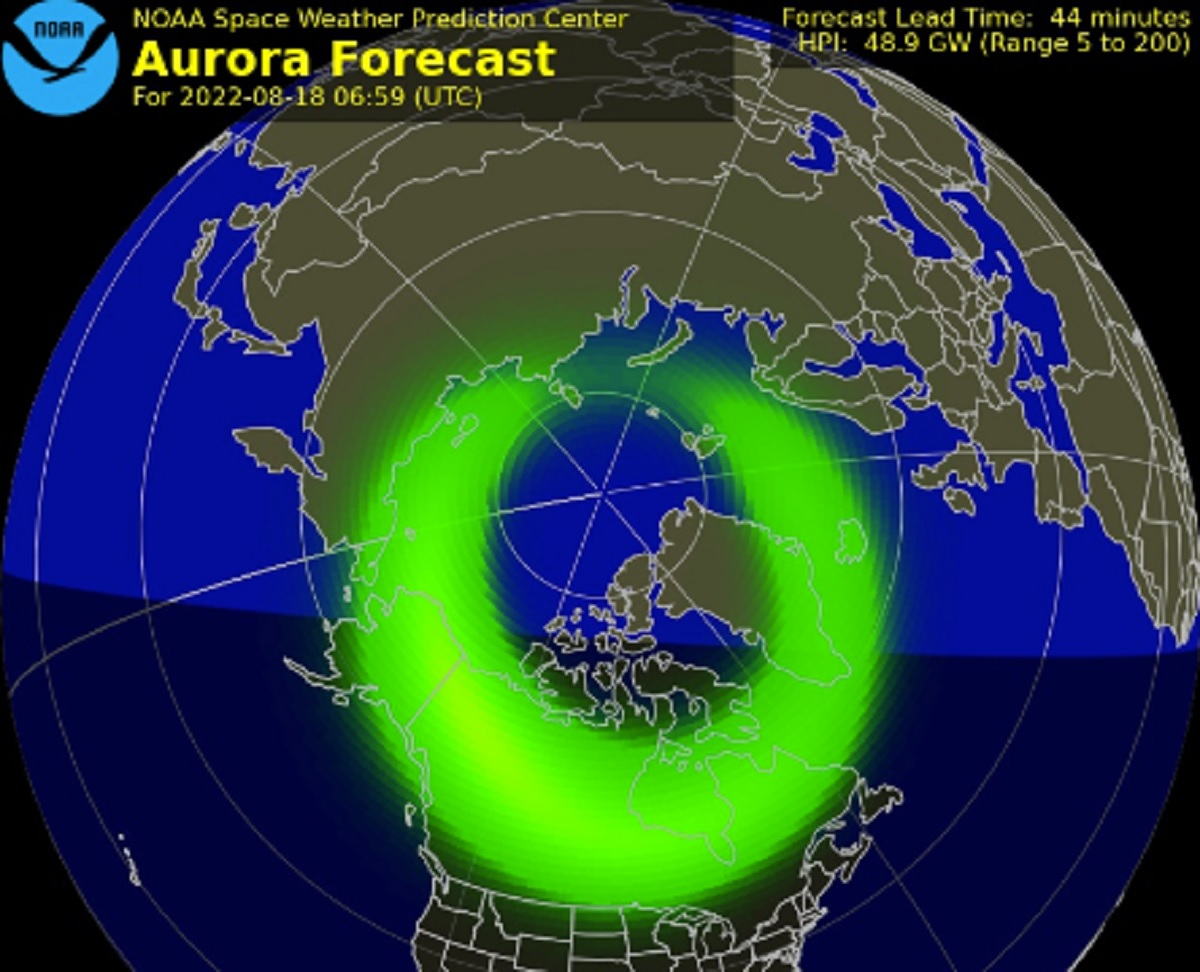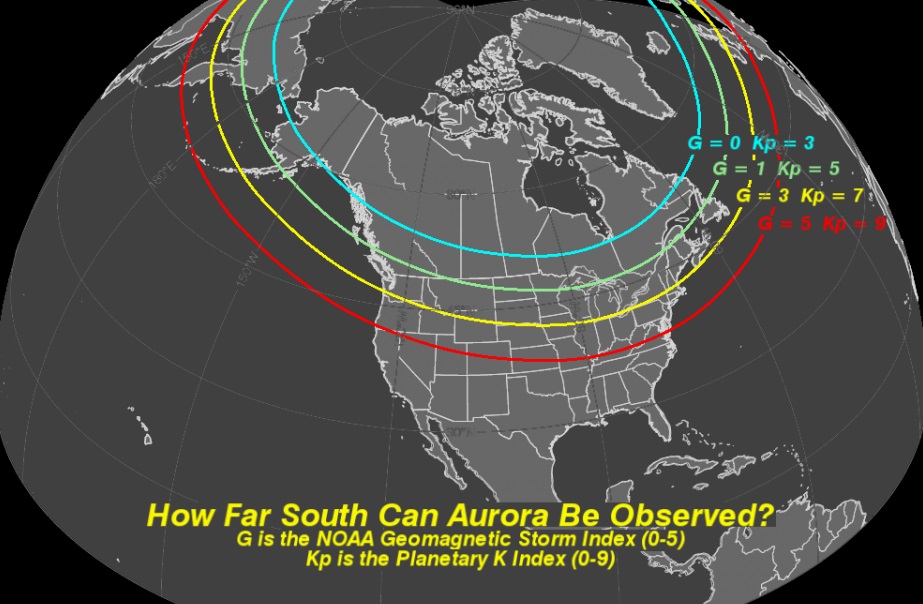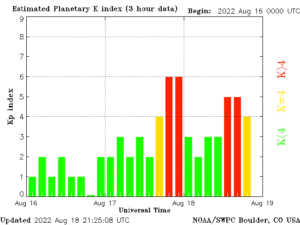
Amateur night sky watchers as well as leading space weather scientists are monitoring the Kp Index to see how far south and how bright the Northern Lights, also known as “aurora”, could be seen during an ongoing moderate geomagnetic storm on Earth. It’s possible aurora will be visible in night skies clear of light pollution and clouds for the next several days in regions where they aren’t very common.
“We saw six hours of moderate geomagnetic storms yesterday, and the disturbed conditions continue today at minor levels,” NOAA’s Space Weather Prediction Center (SWPC) said today in an update. “The storms are being driven by a series of eruptions from the sun arriving at Earth. We expect these disturbances to last through Friday and into Saturday, primarily at the minor to moderate level.”
This geomagnetic storm is due to coronal hole (CH) high speed stream (HSS) and coronal mass ejection (CME) influences. The surge in activity this week is due to the arrival at or near Earth of multiple coronal mass ejections (CMEs) that have departed the Sun since August 14.
A coronal mass ejection, or CME for short, leapt off the sun last Friday; it’s impacts were felt on Earth starting Wednesday evening. A more potent CME left the Sun yesterday, blasting a significant amount of energy towards Earth. Due to this CME activity racing towards earth, NOAA’s Space Weather Prediction Center has issued Geomagnetic Storm Watches for Minor and Moderate intensity storms. It’s possible, but not probable, that the geomagnetic storm could exceed moderate intensity level.
Coronal Mass Ejections (CMEs) are large expulsions of plasma and magnetic field from the Sun’s corona. They can eject billions of tons of coronal material and carry an embedded magnetic field, frozen in flux, that is stronger than the background solar wind interplanetary magnetic field (IMF) strength. CMEs travel outward from the Sun at various speeds, with some reaching the Earth as quickly as 15-18 hours and others requiring days to arrive. According to the SWPC, CMEs expand in size as they propagate away from the Sun and larger ones can reach a size comprising nearly a quarter of the space between Earth and the Sun by the time it reaches our planet. When the impacts arrive on Earth, a geomagnetic storm occurs.

One frequent side effect of these geomagnetic storms is the presence of aurora. The probability and location of aurora displays is based on the Kp index of the storm. The K-index, and by extension the Planetary K-index, are used to characterize the magnitude of geomagnetic storms. The SWPC says that Kp is an excellent indicator of disturbances in the Earth’s magnetic field and is used by SWPC to decide whether geomagnetic alerts and warnings need to be issued for users who are affected by these disturbances. Beyond signifying how bad a geomagnetic storm’s impact can be felt, the Kp index can also help indicate how low, latitude-wise the aurora will be.

The current forecast from the SWPC is calling for a Kp index of 6 or greater. The greater the number, the more vibrant aurora can be; in the Northern Hemisphere, a higher Kp index also means the aurora could establish itself high above the United States in southern locations that don’t ordinarily see the Northern Lights. A KP index of 7 or more could make the aurora present in clear skies in Boston, Chicago, and Seattle; a Kp index of 9 or more could illuminate the clear night skies of Washington, DC, Saint Louis, Denver, and even Salt Lake City. In past severe geomagnetic storms, the aurora has been visible as far south as Hawaii and the central Caribbean.
The latest geomagnetic forecast from the SWPC is calling for a maximum Kp index of 6 right now late tonight / early tomorrow. If that were to materialize, the aurora could be visible in clouds free of light and cloud pollution across the Great Lakes, central New England, the Upper Midwest, and much of Montana and Washington. If the Kp doesn’t reach that intensity, visible aurora could be confined to Canada. If the opposite happens and the Kp surges above forecast level to 7, 8, or even 9, major cities in the Mid Atlantic, across the midwest, and throughout the Pacific Northwest could see the aurora if sky conditions cooperated.
While a higher Kp Index generally produces a more spectacular aurora display, it also presents more of a danger to systems that could be impacted by geomagnetic disturbances. Electrical system failures, grid failures, communication and navigation system faults, and more could happen if the geomagnetic storm is powerful enough.
On September 1-2 in 1859, a powerful geomagnetic storm struck Earth during Solar Cycle 10. A CME hit the Earth and induced the largest geomagnetic storm on record. The storm was so intense it created extremely bright, vivid aurora throughout the planet: people in California thought the sun rose early, people in the northeastern U.S. could read a newspaper at night from the aurora’s bright light, and people as far south as Hawaii and south-central Mexico could see the aurora in the sky. This day became known as the “Carrington Event.” The event severely damaged the limited electrical and communication lines that existed at that time; telegraph systems around the world failed, with some telegraph operators reporting they received electric shocks.
The sun cycles in and out of active periods. One longer solar cycle is known as the Gleissberg cycle; this takes place every 80-100 years. During the Gleissberg cycle, large-scale solar events during solar maxima become four times more likely to occur.
A paper published last year written by University of California assistant professor Sangeetha Abdu Jyothi, entitled “Solar Superstorms: Planning for an Internet Apocalypse”, describes the threats the sun pose to a globe and modern technology dependent on electronics and electricity.
The two most recent solar cycles, from 1996-2008 and 2008-2020, were part of a minimum activity period during the Gleissberg cycle. “In other words, modern technological advancement coincided with a period of weak solar activity and the sun is expected to become more active in the near future,” the paper stated. Because the internet was developed during this minimal activity period, it has never been tested by a period of strong solar activity. And unfortunately for the internet and all those that depend on it, we may be about to begin a period of very strong solar activity.
A paper published last year written by University of California assistant professor Sangeetha Abdu Jyothi, entitled “Solar Superstorms: Planning for an Internet Apocalypse”, describes the threats the sun pose to a globe and modern technology dependent on electronics and electricity.
“A recent study from November 2020 suggested that this cycle has the potential to be one of the strongest on record,” the study author stated. “Recent estimates for the number of sunspots at the peak of this cycle are between 210 and 260 (a very high value). In contrast, the previous cycle that ended in 2019 had a peak sunspot number f 116. Since CMEs often originate in magnetically active regions near sunspots, a larger number of sunspots will increase the probability of a powerful CME. If this estimate proves accurate, it will also significantly increase the probability of a large-scale event in this decade.”
CMEs produce variations in the earth’s magnetic field, which in turn induce geoelectric fields on the earth’s conducting surface, such as the land or ocean floor. The paper’s author describes how a CME impacts cables: “These spatiotemporally varying electric fields are responsible for the generation of Geomagnetically Induced Currents (GIC) as high as 100-130 Amps that can flow through any extended ground-based conductive systems such as power grids, networking cables, etc. This electromagnetically induced current enters/exits long-distance conductors from grounded neutral, causing destruction of electrical equipment such as transformers/repeaters and, in turn, large-scale power outages/Internet outages spanning many states or even countries.”
Based on this, power grids, oil and gas pipelines, and networking cables –including those the internet depends on– are the most vulnerable from a strong solar blast. In addition to damaging things on Earth, a strong solar blast could also damage things in space, such as communications satellite. If the blast is strong enough and a geomagnetically induced current is allowed to harm network infrastructure, the internet could be effectively killed until repairs are made. On a global scale, this could take weeks or months; some areas may not ever be able to be restored.
While the exact timing of such a solar blast isn’t known, scientists are fairly confident an internet-killing blast is likely at some point in the future. Worse, it appears the United States is more vulnerable than other countries around the world. “The U.S. is one of the most vulnerable locations with a high risk of disconnection from Europe during extreme solar events,” the study said. “Intracontinental connections in Europe are at a lower risk due to the presence of a large number of shorter land and submarine cables interconnecting the continent.”